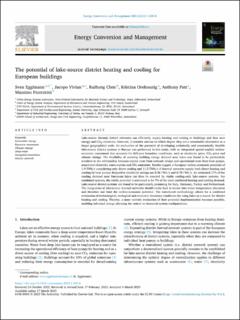Please use this identifier to cite or link to this item:
https://doi.org/10.21256/zhaw-27813Full metadata record
| DC Field | Value | Language |
|---|---|---|
| dc.contributor.author | Eggimann, Sven | - |
| dc.contributor.author | Vivian, Jacopo | - |
| dc.contributor.author | Chen, Ruihong | - |
| dc.contributor.author | Orehounig, Kristina | - |
| dc.contributor.author | Patt, Anthony | - |
| dc.contributor.author | Fiorentini, Massimo | - |
| dc.date.accessioned | 2023-05-11T08:57:50Z | - |
| dc.date.available | 2023-05-11T08:57:50Z | - |
| dc.date.issued | 2023-05-01 | - |
| dc.identifier.issn | 0196-8904 | de_CH |
| dc.identifier.issn | 1879-2227 | de_CH |
| dc.identifier.uri | https://digitalcollection.zhaw.ch/handle/11475/27813 | - |
| dc.description.abstract | Lake-source thermal district networks can efficiently supply heating and cooling to buildings and thus save energy and CO2 emissions. However, it remains unclear to which degree they are a sustainable alternative at a larger geographical scale. An evaluation of the potential of developing technically and economically feasible lake-source district systems in Europe was performed in this study, with an integrated spatial explicit techno-economic assessment that accounts for different boundary conditions, such as electricity price, CO2 price and climate change. The feasibility of covering building energy demand near lakes was found to be particularly sensitive to the relationship between capital costs from network design and operational costs from heat pumps, associated electricity consumption and CO2 emissions. Results suggest a European techno-economic potential of 1.9 TWh/y considering only direct cooling and 11.3 TWh/y if thermal networks supply both direct heating and cooling by heat pumps. Respective electricity savings are 0.36 TWh/y and 0.78 TWh/y. An estimated 17% of the cooling demand near European lakes can thus be covered by viable cooling-only lake-source systems. For combined systems, the viable potential is estimated to be 7% of the total combined heating and cooling demand. Lake-source district systems are found to be particularly promising for Italy, Germany, Turkey and Switzerland. The integration of lake-source thermal networks should rarely lead to severe lake water temperature alteration and therefore not limit the techno-economic potential. The introduced methodology allows for a combined evaluation of technological, ecological and economic boundary conditions for using lakes as a source for district heating and cooling. Thereby, a more realistic estimation of their potential implementation becomes possible, enabling informed energy planning for central or decentral system configurations. | de_CH |
| dc.language.iso | en | de_CH |
| dc.publisher | Elsevier | de_CH |
| dc.relation.ispartof | Energy Conversion and Management | de_CH |
| dc.rights | http://creativecommons.org/licenses/by/4.0/ | de_CH |
| dc.subject | Renewable energy | de_CH |
| dc.subject | Resource assessment | de_CH |
| dc.subject | Climate change | de_CH |
| dc.subject | Deep-water | de_CH |
| dc.subject | Geospatial simulation | de_CH |
| dc.subject | District network | de_CH |
| dc.subject.ddc | 333.79: Energie | de_CH |
| dc.title | The potential of lake-source district heating and cooling for European buildings | de_CH |
| dc.type | Beitrag in wissenschaftlicher Zeitschrift | de_CH |
| dcterms.type | Text | de_CH |
| zhaw.departement | Architektur, Gestaltung und Bauingenieurwesen | de_CH |
| zhaw.organisationalunit | Institut Bautechnologie und Prozesse (IBP) | de_CH |
| dc.identifier.doi | 10.1016/j.enconman.2023.116914 | de_CH |
| dc.identifier.doi | 10.21256/zhaw-27813 | - |
| zhaw.funding.eu | No | de_CH |
| zhaw.issue | 116914 | de_CH |
| zhaw.originated.zhaw | Yes | de_CH |
| zhaw.publication.status | publishedVersion | de_CH |
| zhaw.volume | 283 | de_CH |
| zhaw.publication.review | Peer review (Publikation) | de_CH |
| zhaw.author.additional | No | de_CH |
| zhaw.display.portrait | Yes | de_CH |
| Appears in collections: | Publikationen Architektur, Gestaltung und Bauingenieurwesen | |
Files in This Item:
| File | Description | Size | Format | |
|---|---|---|---|---|
| 2023_Eggimann-etal_Lake-source-district-heating-and-cooling-potential.pdf | 8.52 MB | Adobe PDF |  View/Open |
Show simple item record
Eggimann, S., Vivian, J., Chen, R., Orehounig, K., Patt, A., & Fiorentini, M. (2023). The potential of lake-source district heating and cooling for European buildings. Energy Conversion and Management, 283(116914). https://doi.org/10.1016/j.enconman.2023.116914
Eggimann, S. et al. (2023) ‘The potential of lake-source district heating and cooling for European buildings’, Energy Conversion and Management, 283(116914). Available at: https://doi.org/10.1016/j.enconman.2023.116914.
S. Eggimann, J. Vivian, R. Chen, K. Orehounig, A. Patt, and M. Fiorentini, “The potential of lake-source district heating and cooling for European buildings,” Energy Conversion and Management, vol. 283, no. 116914, May 2023, doi: 10.1016/j.enconman.2023.116914.
EGGIMANN, Sven, Jacopo VIVIAN, Ruihong CHEN, Kristina OREHOUNIG, Anthony PATT und Massimo FIORENTINI, 2023. The potential of lake-source district heating and cooling for European buildings. Energy Conversion and Management. 1 Mai 2023. Bd. 283, Nr. 116914. DOI 10.1016/j.enconman.2023.116914
Eggimann, Sven, Jacopo Vivian, Ruihong Chen, Kristina Orehounig, Anthony Patt, and Massimo Fiorentini. 2023. “The Potential of Lake-Source District Heating and Cooling for European Buildings.” Energy Conversion and Management 283 (116914). https://doi.org/10.1016/j.enconman.2023.116914.
Eggimann, Sven, et al. “The Potential of Lake-Source District Heating and Cooling for European Buildings.” Energy Conversion and Management, vol. 283, no. 116914, May 2023, https://doi.org/10.1016/j.enconman.2023.116914.
Items in DSpace are protected by copyright, with all rights reserved, unless otherwise indicated.